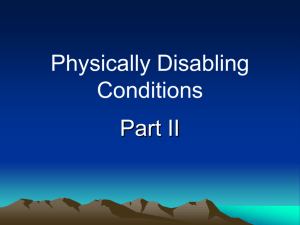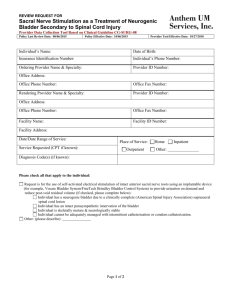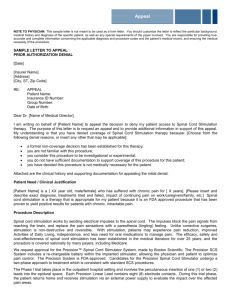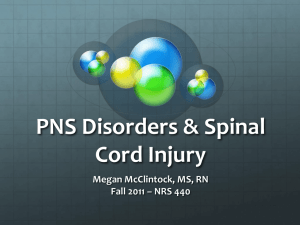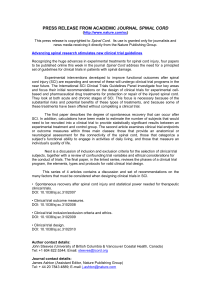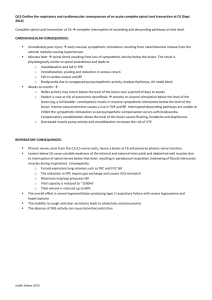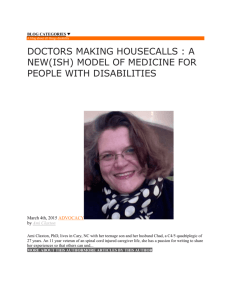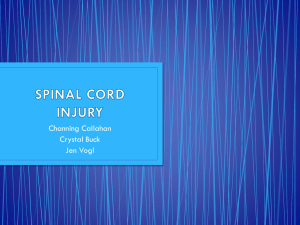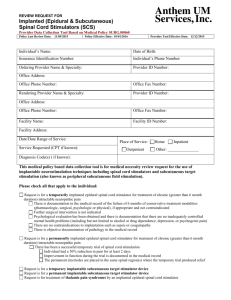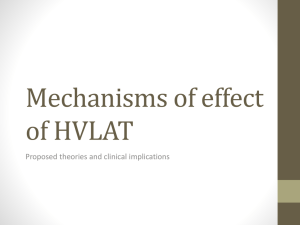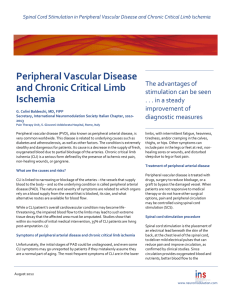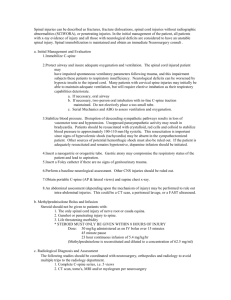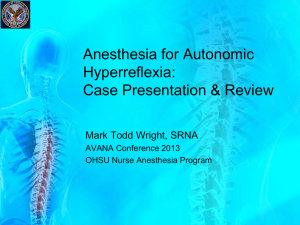分數一般評估
advertisement
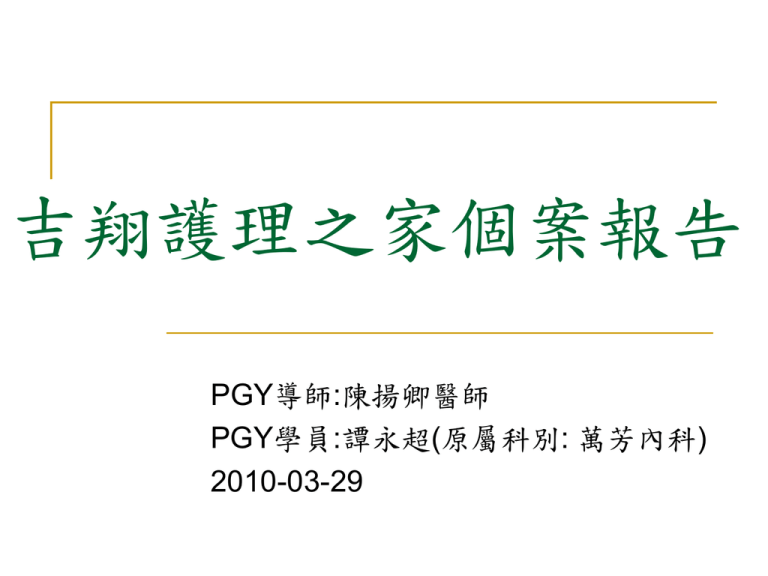
吉翔護理之家個案報告 PGY導師:陳揚卿醫師 PGY學員:譚永超(原屬科別: 萬芳內科) 2010-03-29 個案基本資料 姓名:林文華 年齡:39歲 (出生日期:1971-01-03) 教育程度:大專畢業 語言:台, 國語 職業:服務業,電話諮詢 個案基本資料 婚姻:未婚 宗教:無 個性:善談,性格堅強積極 收案日期:2005-03-12 資料來源:案主 個案主訴 四肢感覺異常併無力需輪椅助行。 小便失禁及便秘,長期使用軟便藥,使用導尿管。 因長期下肢水腫,需要長期使用利尿劑。 個案病史(1) 2001年秋因興趣加入化妝訓練,後因有手汗的緣故, 無法繼續訓練,因不想半途而廢而就就醫,醫師建議 施行除汗腺手術。後因手術後常常出現全身無力,頭 暈,期間持續醫,但也無法改善。 2003年於一次郊遊中發生意外,從山上滾下,意外發 生時病人巳失去意識,後來由直昇機救治並送往醫院 救治,手術後雖能保住性命,但因傷及頸部C3,C4,導 致半身不遂。 個案病史(2) 病人在意外發生後三個月期間,情緒常常不穩, 後來經家人和宗教團體支持,方能慢慢接事。 因小便無法控制,長期使用導尿管。 雙手的行動上有所改善,能進行一些簡單的抓 握的動作,下肢需電動輪椅助行。 個案於 2005年轉入護理之家療養。 個案病史(3) 意外發生後兩年期間,個案常因泌尿道感染, 多次進出醫院,曾有考慮是否進行Suprapubic cystostomy,但因長期傷口照謢,並沒有施行 手術。後來訪尋中醫,定期服用中藥,感染情 況得以改善 個案過去病史 住院 Urinary tract infection 開刀 Traumatic spinal cord injury s/p transection 個案個人史 Smoking(-) Alcohol consumption(-) Betel nut chewing(-) Drug or food allergy: denied Travel or animal contact history: denied 個案病史 現在用藥 Dilantin 100mg 1# qd Furide 40mg 0.5# qd Bisacodyl (Bisacodyl 5mg) 2# bid 血液檢查2009-08 CBC, SMA Uric acid 5.3 Alb 3.8 Hb 13.2 U/A Clear, yellow Bacteria +++ WBC 20-30 血液檢查2009-08 ACTH: 43.9(之前有懷疑過adrenal insufficiency) Free T4: 1.29 TSH: 1.06 Cortisol: 13.1 Prolactin: 23.8 Renin: 2.06 Aldosterone: 124.8 個案診斷 2005 Traumatic spinal cord injury(C3-C4) s/p transection Frequent urinary tract infection Hepatitis B carrier 日常生活巴氏量表 (Barthel Index) 進食 需別人協助取用或切好食物或使用進食輔具 5 移位 需別人協助才能坐起,或需別人幫忙才可移位 0 個人衛生 需別人協助刷牙、洗臉、洗手及梳頭髮 0 如廁 無法自行完成如厠過程 0 洗澡 無法自行完成沐浴 0 平地走動 獨立操作輪椅,可行走50公尺以上 5 上下樓梯 無法上下樓梯 0 穿脫衣褲鞋襪 無法自行穿脫 0 大便控制 偶爾會失禁,使用塞劑時需要別人幫忙 5 小便控制 長期用尿管 0 總分(100) 15 迷你營養評估簡式MNA-SF MNA-SF=12 正常 迷你營養評估 MNA 一般評估 分數 7. 可以獨立生活 (非住在護理之家 或醫院) 0分=否 ; 1分=是 0 8. 每天需服用三種以上的處方藥物 0分=是 ; 1分=否 0 9. 褥瘡或皮膚潰瘍 0分=是 ; 1分=否 1 10. 一天中可以吃幾餐完整的餐食 0分 = 1餐 ; 1分 = 2餐 2分 = 3餐 2 迷你營養評估 MNA 一般評估 11. 蛋白質攝取量 每天至少攝取一份乳製品(牛奶、乳酪、優酪乳) 是■ 否□ 每週攝取兩份以上的豆類或蛋類 是■ 否 每天均吃些肉、魚、雞鴨類 是■ 否 分數 1 0.0分 = 0 或1個是 0.5分 = 2個是 1.0分 = 3個是 12. 每天至少攝取二份或二份以上的蔬菜 或水果 0分=否 ; 1分=是 13. 每天攝取多少液體 (包括開水、果汁、 咖啡、 茶、牛奶) (一杯 = 240 c.c.) 0.0分 = 少於三杯 0.5分 = 3 ~ 5杯 1.0分 = 大於5杯 14. 進食的形式 0分 = 無人協助則無法進食 1分 = 可以自己進食但較吃力 2分 = 可以自己進食 1 0.5 0 迷你營養評估 MNA 一般評估 分數 15. 他們覺得自己營養方面有沒有問題? 0分 = 覺得自己營養非常不好 1分 = 不太清楚或營養不太好 2分 = 覺得自己沒有營業問題 2 16. 與其他同年齡的人比較,他們認為自己的 健康狀況如何? 0.0 分 = 不如同年齡的人 0.5 分 = 不知道 1.0 分 = 和同年齡的人差不多 2.0 分 = 比同年齡的人好 1 17. 臂中圍MAC: 公分 0.0分 = MAC < 21 0.5分 = MAC 21 ~ 21.9 1.0分 = MAC ≧ 22 1 18. 小腿圍C.C.: 0分 = C.C. < 31 1分 = C.C. ≧ 31 1 公分 總分 22.5/30 正常 Discussion Rehabilitation of Persons With Spinal Cord Injuries Common Medical Problems Thromboembolic disease Autonomic dysfunction Neuropathic pain Neurogenic bladder dysfunction Neurogenic bowel Heterotopic bone formation Pressure ulceration Spasticity Thromboembolic disease The risk of death from PE during the first year following SCI is more than 200 times that for the general population. DVT most commonly occurs in the weeks following SCI, with a much lower risk in persons with chronic injury. Autonomic dysfunction Problems are most common in those with injuries to level T6 and above Orthostatic hypotension Bradycardia autonomic hyperreflexia lethal complication patients with spinal injuries above T7 bladder and bowel distention headache in the presence of elevated blood pressure Neurogenic bladder dysfunction Detrusor-sphincter dyssynergy unable to cause efficient voiding Urinary tract calculi Hydronephrosis Mortality Mortality is highest in the first year after injury In the past At present urinary tract disease and renal failure pneumonia Nonischemic heart disease Sepsis Pulmonary embolus leading causes of death for younger patient (paraplegia) Functional Rehabilitation Neurologic recovery Patients can be classified based on the ASIA impairment scale from A to E (1) recovery within the zone of injury (2) recovery below the zone of injury The zone of injury is typically considered the first 3 abnormal dermatomes or myotomes. ASIA impairment scale Expected levels of function Expectations according to injury level A person with tetraplegia with injury above the level of C5 is dependent upon others for activities such as feeding, dressing, and bathing, and requires the availability of an attendant at all times Expected functional recovery following complete spinal cord injury by spinal level Activities of daily living Mobility/locomotion C1-C4 Feeding possible with balanced forearm orthoses Computer access by tongue, breath, voice controls Weight shifts with power tilt and recline chair Mouth stick use Operate power chair with tongue, chin, or breath controller C5 Drink from cup, feed with static splints and setup Oral/facial hygiene, writing, typing with equipment Dressing upper body possible Side-to-side weight shifts Propel chair with hand rim projections short distances on smooth surfaces Power chair with hand controller C6 Feed, dress upper body with setup Dressing lower body possible Forward weight shifts Bed mobility with equipment Level surface transfers with assistance Propel indoors with coated hand rims C7 Independent feeding, dressing, bathing with adaptive equipment, built-up utensils Independent bed mobility, level surface transfers Wheelchair use outdoors (power chair for school or work) C8 Independent in feeding, dressing, bathing Bowel and bladder care with setup Propel chair, including curbs and wheelies Wheelchair-to-car transfers T1 Independent in all self-care Transfer from floor to wheelchair Spinal level T2-L1 Stand with braces for exercise L2 Potential for swing-to gait with long leg braces indoors Use of forearm crutches L3 Potential for community ambulation Potential for ambulation with short leg braces L4-S1 Potential for ambulation without assistive devices Sip and puff straws, which are activated by blowing and sucking air, can help control everything from the phone to the TV A powered wheelchair is commonly used by tetraplegics. In many cases, there is very subtle control left in one or both hands -- combine that with an extremely sensitive joystick, and wheelchair control is possible. Gait Functional ambulation may become possible for patients admitted with ASIA B tetraplegia. Sparing of sacral pin sensation may indicate a favorable prognosis Most patients with no lower extremity function are not trained in gait Upper extremity reconstructive surgery Offers the opportunity to utilize an innervated but nonessential muscle to provide a lost function. not considered until a year following injury well developed for the upper limb but not for the lower limb Example A person with a spinal injury level of C5 may have good shoulder control and strong elbow flexion. Active elbow extension is lacking, making overhead activity impossible. Such a person may benefit from a transfer procedure to the triceps tendon. One of the muscles available for transfer is the posterior deltoid. Functional neuromuscular stimulation Electrical stimulation of intact peripheral nerves increases contraction in muscles paralyzed by upper motor neuron injury. transcutaneous, percutaneous, or implanted electrodes. Stimulation can be useful for exercise and for function. Functional neuromuscular stimulation (FNS) can be used in the upper extremity to provide lateral pinch and palmar grasp to persons with, for example, C5 and C6 tetraplegia. Upper extremity FNS often is combined with tendon transfer surgery Prognosis One-Year Follow-up Frankel Grade Admission* Frankel Grade A B C D A 84% 8% 5% 3% B 10% 30% 29% 31% C 2% 2% 25% 67% D 2% 1% 2% 85% Life In The Community Fertility most women typically experience amenorrhea that can last for up to a year. SCI does not contraindicate pregnancy No prospective studies have examined fertility rates or pregnancy complications in these patients. Sexuality Vaginal vasocongestion can occur in response to local stimulation Women with complete injuries above T6 do not demonstrate vaginal vasocongestion in response to psychogenic stimulation alone the isolation of the brain from the sympathetic outflow to the genitals References Chronic complications of spinal cord injury UpToDate updated: Sep, 2009 Rehabilitation of Persons With Spinal Cord Injuries E-medicine Updated: Nov 4, 2009
